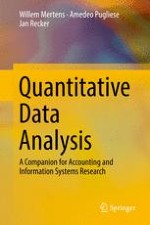2017 | OriginalPaper | Buchkapitel
6. Analyzing Longitudinal and Panel Data
verfasst von : Willem Mertens, Amedeo Pugliese, Jan Recker
Erschienen in: Quantitative Data Analysis
Aktivieren Sie unsere intelligente Suche, um passende Fachinhalte oder Patente zu finden.
Wählen Sie Textabschnitte aus um mit Künstlicher Intelligenz passenden Patente zu finden. powered by
Markieren Sie Textabschnitte, um KI-gestützt weitere passende Inhalte zu finden. powered by
